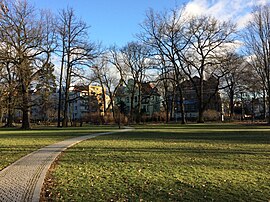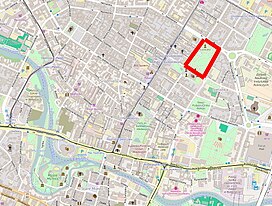Jan Kochanowski Park in Bydgoszcz
| Jan Kochanowski Park | |
|---|---|
| Polish: Park Jana Kochanowskiego w Bydgoszczy | |

Jan Kochanowski Park
|
|

Location on Bydgoszcz map
|
|
| Location | Bydgoszcz, Poland |
| Coordinates | 53°07′47″N 18°00′42″E / 53.12972°N 18.01167°ECoordinates: 53°07′47″N 18°00′42″E / 53.12972°N 18.01167°E |
| Area | 3.15 hectares (31,500 m2) |
| Elevation | 50 metres (160 ft) |
| Created | 1901 |
| Designer | Konrad Neumann |
| Owned by | City of Bydgoszcz |
Jan Kochanowski Park is a green area covering 3,15 ha, located in downtown Bydgoszcz, Poland. It is part of the so-called "Music district in Bydgoszcz" (Polish: Dzielnica muzyczna w Bydgoszczy).
The park is located in an area urbanized at the beginning of the 20th century. The park is rectangular, with dimensions 120 × 250 m, and is delineated by the following avenues:
Due to the proximity of several musical institutions (Pomeranian Philharmonic, Polish Theatre in Bydgoszcz, Bydgoszcz Music Academy, Music Schools Group), as well as the outdoor gallery of monuments of composers and virtuoso, the park and its surroundings are called Music district in Bydgoszcz.
The park has been designed by Konrad Neumann, then director of the Municipal gardens of Bromberg in 1901; its initial surface was 2.8 hectares (28,000 m2). It was part of urban plans laid out in 1903, and developed through 1911 The design was inspired from English gardens, with about 80 species of trees and ornamental trees, mainly endemical native species. The main entrance was located at Bismark Platz, today at the junction between Słowackiego and January 20, 1920 streets. The northern edge on Bulöw Straße (Adam Mickiewicz Alley) was a lawn planted with roses and low shrubs.
In January 1920, Bydgoszcz joined the re-created state of Poland. On July 31, 1927, a ceremony unveiled in the park the monument to Henryk Sienkiewicz, first of its kind in the country.
In 1938, a survey in registered 84 species of trees and shrubs including:white birch, common hawthorn, alders, sweet chestnuts, silver berry, common salt trees, walnut trees, magnolias, jasmines, poplars, silver poplars, cherry trees, English oaks, robinias, sumacs, elder berries, willows, lime trees, elms, basalm trees, firs, white firs, sawara cypresses, Norway spruces, blue spruces, mountain pines, pine trees, Swiss pines, English yews, ashleaf maples, ailanthus, sycamores, Norway maples, field maples, silver maples, horse-chestnuts, horse-chestnuts, beeches, European beeches, hornbeams and European hornbeams.
...
Wikipedia
